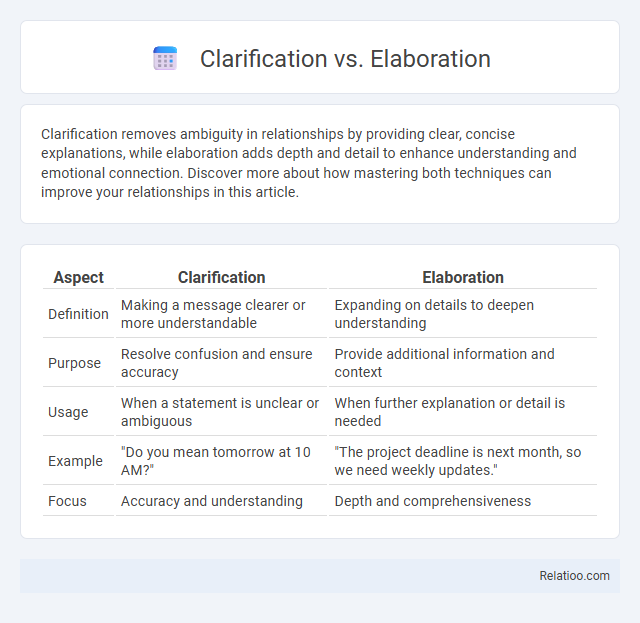Clarification removes ambiguity in relationships by providing clear, concise explanations, while elaboration adds depth and detail to enhance understanding and emotional connection. Discover more about how mastering both techniques can improve your relationships in this article.
Table of Comparison
| Aspect | Clarification | Elaboration |
|---|---|---|
| Definition | Making a message clearer or more understandable | Expanding on details to deepen understanding |
| Purpose | Resolve confusion and ensure accuracy | Provide additional information and context |
| Usage | When a statement is unclear or ambiguous | When further explanation or detail is needed |
| Example | "Do you mean tomorrow at 10 AM?" | "The project deadline is next month, so we need weekly updates." |
| Focus | Accuracy and understanding | Depth and comprehensiveness |
Introduction to Clarification and Elaboration
Clarification involves making your message clear and understandable by providing simple explanations or removing ambiguity, ensuring Your audience grasps the core meaning. Elaboration expands on ideas by adding detailed examples, descriptions, or reasons to deepen understanding and engagement. Together, clarification and elaboration enhance communication effectiveness by balancing simplicity with comprehensive information.
Defining Clarification
Clarification involves providing a clear and concise explanation to remove confusion or ambiguity surrounding a statement or concept. It aims to ensure mutual understanding by addressing specific questions or uncertainties without adding excessive detail. Unlike elaboration, which expands on ideas with additional information, clarification strictly targets making the original message more understandable and precise.
Understanding Elaboration
Elaboration involves expanding on an idea by providing detailed information, examples, or explanations to enhance comprehension and depth of knowledge. Unlike clarification, which aims to clear up confusion or ambiguity, elaboration deepens understanding by adding context and richness to your message. Mastering elaboration techniques helps you communicate complex concepts more effectively and engage your audience thoroughly.
Key Differences Between Clarification and Elaboration
Clarification involves making information clearer and resolving confusion by restating or simplifying concepts, while elaboration provides additional details and examples to deepen understanding. Clarification targets ambiguity and misunderstanding, ensuring your message is precise, whereas elaboration enhances content richness by expanding on initial ideas. Recognizing these key differences helps you communicate more effectively depending on whether your goal is to clear up confusion or enrich the information presented.
Importance of Clarification in Communication
Clarification ensures your message is understood accurately, preventing misunderstandings and fostering effective communication. Unlike elaboration, which adds detail, or reiteration, which repeats information, clarification zeroes in on resolving confusion and verifying meaning. Your ability to clarify strengthens relationships and enhances collaboration by making intentions clear and expectations aligned.
Advantages of Elaboration in Information Sharing
Elaboration enhances information sharing by providing detailed explanations that improve understanding and retention, allowing you to grasp complex concepts more thoroughly. It adds context and examples that clarify ambiguous points, reducing misunderstandings and increasing communication effectiveness. This depth of detail supports critical thinking and decision-making in academic, professional, and everyday interactions.
When to Use Clarification vs Elaboration
Clarification is essential when the information provided is ambiguous or unclear, requiring concise explanation to remove confusion and ensure accurate understanding. Elaboration is used to expand on a topic with additional details, examples, or context to deepen comprehension or provide more comprehensive insight. Use clarification when the primary goal is to resolve uncertainty, whereas elaboration is appropriate to enrich the content and offer further explanation beyond the basic facts.
Common Misconceptions About Clarification and Elaboration
Clarification often gets confused with elaboration, but clarification specifically aims to remove confusion by making a statement clearer, while elaboration adds detailed information to expand understanding. Common misconceptions include thinking that clarification always requires extensive explanation, when it actually involves concise restating or rephrasing. Your ability to distinguish between these terms enhances effective communication, ensuring the right approach is used to address confusion versus enrich content.
Practical Examples: Clarification vs Elaboration
Clarification removes ambiguity by restating or simplifying information, such as rephrasing a confusing instruction to ensure Your understanding. Elaboration expands on details, offering deeper insight, like providing examples or background to a statement. For instance, if a teacher asks, "What do you mean by that?" they're seeking clarification, whereas prompting "Can you explain that further?" requests elaboration.
Conclusion: Enhancing Communication Through Clarification and Elaboration
Enhancing communication through clarification and elaboration ensures your message is both clear and comprehensive, minimizing misunderstandings. Clarification focuses on resolving ambiguities, while elaboration expands on ideas to provide depth and context. Leveraging both techniques optimizes understanding and strengthens the impact of your communication.

Infographic: Clarification vs Elaboration
 relatioo.com
relatioo.com